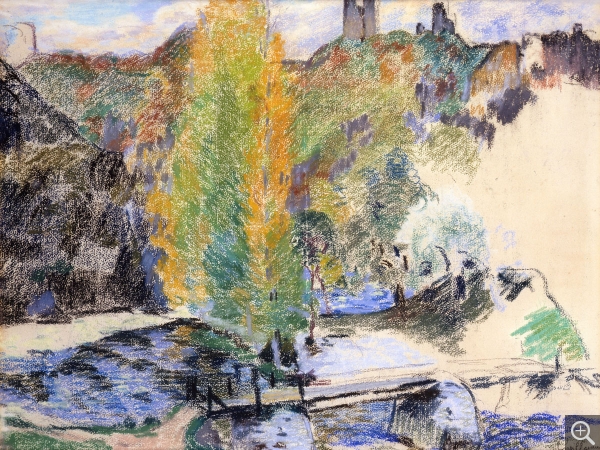Impressionism
English
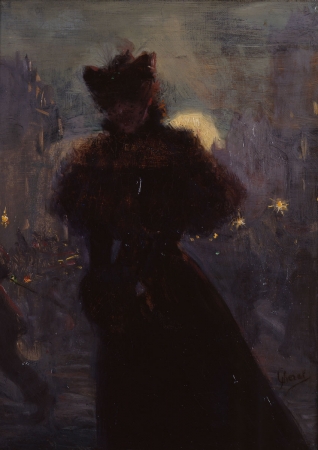
Jules CHÉRET (1836-1932)
Woman in Black with Muff
ca. 1885
oil on canvas
33 x 25 cm
© MuMa Le Havre / Florian Kleinefenn
Woman in Black with Muff
ca. 1885
oil on canvas
33 x 25 cm
© MuMa Le Havre / Florian Kleinefenn
HD image
Jules Chéret, who Gustave Geffroy asserted had "raised the poster to the rank of mural art", painted as a leisure pursuit until 1900, when he began devoting more time to the practice. With a cheerful and pleasant character that shone through in his work, he succeeded in creating a certain ideal of the Belle Époque Parisian woman. Similar to the Impressionists, he excelled in capturing the glittering magic of the Parisian nightlife.
Woman in Black with Muff provides the perfect example of this art form, done with elegance and suggestion. The dynamic movement of the silhouetted young woman is accentuated by the furtive, half-hidden shadow of a passer-by in the left of the painting. He used this framing, which resembles the work of his friends Toulouse-Lautrec and Degas, teamed with the bright gleam of the city lights, to convey the fast-paced and ever-changing life of the Grands Boulevards. The impish nose and witty mouth of a mischievous face can be glimpsed beneath the elegant lady's half-veil.
Yet the rather dark treatment of the painting may seem surprising for an artist who usually favours airier compositions with livelier brushstrokes. The process adopted for this painting readily evokes the sketches of his contemporary Jean Béraud, who explored the same subject matters as Chéret. This atypical work demonstrates the care Olivier Senn took to broaden his collections to these epigones of Impressionism who, by the vitality and inventiveness of their art, cast their influence on the Post-Impressionist generation.
Painter and lithographer of the frivolity and futility of Parisian pleasures, Jules Chéret distinguished himself by a skilful use of primary colours that held particular interest for Seurat and Cross, and by his concise quality of drawing whose influence reached as far as the Cloisonnist investigations of Gauguin and Bernard. The Woman in Black with Muff thus establishes a link between the purely Impressionist works of his collection and the paintings of Cross, Sérusier, Bonnard and Vallotton.
Woman in Black with Muff provides the perfect example of this art form, done with elegance and suggestion. The dynamic movement of the silhouetted young woman is accentuated by the furtive, half-hidden shadow of a passer-by in the left of the painting. He used this framing, which resembles the work of his friends Toulouse-Lautrec and Degas, teamed with the bright gleam of the city lights, to convey the fast-paced and ever-changing life of the Grands Boulevards. The impish nose and witty mouth of a mischievous face can be glimpsed beneath the elegant lady's half-veil.
Yet the rather dark treatment of the painting may seem surprising for an artist who usually favours airier compositions with livelier brushstrokes. The process adopted for this painting readily evokes the sketches of his contemporary Jean Béraud, who explored the same subject matters as Chéret. This atypical work demonstrates the care Olivier Senn took to broaden his collections to these epigones of Impressionism who, by the vitality and inventiveness of their art, cast their influence on the Post-Impressionist generation.
Painter and lithographer of the frivolity and futility of Parisian pleasures, Jules Chéret distinguished himself by a skilful use of primary colours that held particular interest for Seurat and Cross, and by his concise quality of drawing whose influence reached as far as the Cloisonnist investigations of Gauguin and Bernard. The Woman in Black with Muff thus establishes a link between the purely Impressionist works of his collection and the paintings of Cross, Sérusier, Bonnard and Vallotton.
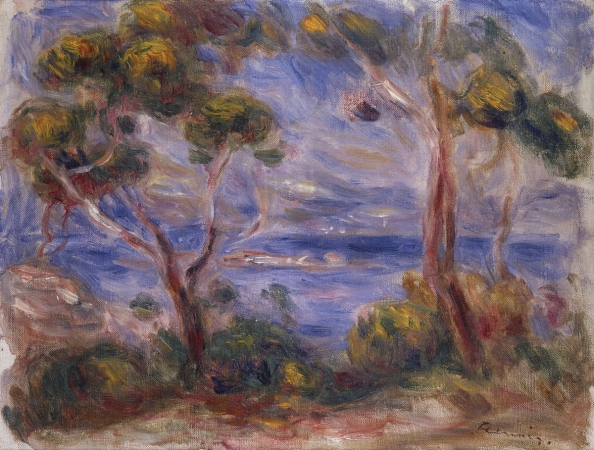
Pierre-Auguste RENOIR (1841-1919)
Pines at Cagnes
ca. 1919
oil on canvas, marouflage on cardboard
31.5 x 38.7 cm
© MuMa Le Havre / Florian Kleinefenn
Pines at Cagnes
ca. 1919
oil on canvas, marouflage on cardboard
31.5 x 38.7 cm
© MuMa Le Havre / Florian Kleinefenn
HD image
While Renoir was most happy to be thought of as a painter of figures, works that critics felt represented the best of his production, the artist practised landscape painting throughout his career. In Pines at Cagnes, Renoir shows himself to be a highly skilled colourist. Planted firmly with two pines that give it stability, this piece is done with very dry paint that often lets the grain of the canvas show through.
The freedom of brushstroke is such that it seems the artist had painted the piece intuitively just the night before. The tiny horizon line tends to blend the sky and sea together in a single stretch of blue, while the sparse vegetation in the foreground, specific to Mediterranean landscapes, is given such swift treatment that the entire painting would become difficult to read if the pines were not there to indicate it is indeed a landscape.
Painted in rather cool tones, the artwork is nevertheless highlighted with golden yellows that shine in the pine needles. In the lower section, a single drop of crimson deposited at the base of the left pine resonates with the green bushes nearby. A few touches of white impasto in the branches suffice for Renoir to locate the action of the light. He uses a red base to paint the trunks of the trees, but varies the values from pink to brown, depending on the part of the bark exposed to the light.
In the leaves, he reproduces what he has learned from his time spent observing nature: "The colour isn't on the leaves, but in the empty spaces." And so he alternates between faded greens, pale yellows and dusty roses amongst the pine branches, echoing the colours used in the foliage.
This limpid painting, which seems to have been done quickly like a sketch, is the consecration of an artist's talent. Not long before his death, Renoir succeeded in rendering instinctive what had been for him a lifelong exploration of the craft.
The freedom of brushstroke is such that it seems the artist had painted the piece intuitively just the night before. The tiny horizon line tends to blend the sky and sea together in a single stretch of blue, while the sparse vegetation in the foreground, specific to Mediterranean landscapes, is given such swift treatment that the entire painting would become difficult to read if the pines were not there to indicate it is indeed a landscape.
Painted in rather cool tones, the artwork is nevertheless highlighted with golden yellows that shine in the pine needles. In the lower section, a single drop of crimson deposited at the base of the left pine resonates with the green bushes nearby. A few touches of white impasto in the branches suffice for Renoir to locate the action of the light. He uses a red base to paint the trunks of the trees, but varies the values from pink to brown, depending on the part of the bark exposed to the light.
In the leaves, he reproduces what he has learned from his time spent observing nature: "The colour isn't on the leaves, but in the empty spaces." And so he alternates between faded greens, pale yellows and dusty roses amongst the pine branches, echoing the colours used in the foliage.
This limpid painting, which seems to have been done quickly like a sketch, is the consecration of an artist's talent. Not long before his death, Renoir succeeded in rendering instinctive what had been for him a lifelong exploration of the craft.
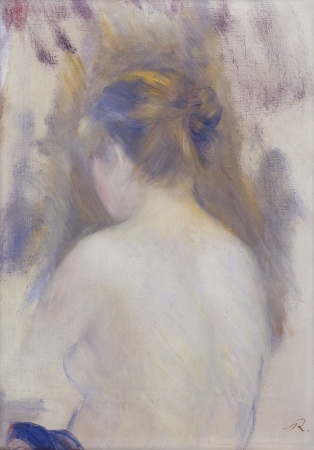
Pierre-Auguste RENOIR (1841-1919)
Woman Seen from the Back
ca. 1875-1879
oil on canvas
27.1 x 22.1 cm
© MuMa Le Havre / Florian Kleinefenn
Woman Seen from the Back
ca. 1875-1879
oil on canvas
27.1 x 22.1 cm
© MuMa Le Havre / Florian Kleinefenn
HD image
"The simplest subjects are eternal. The naked woman rises either from the sea or from her bed; she is called Venus or Nini—there is no better way of portraying it." These were the words of Renoir, who shared with Degas a keen interest in female nudes. But while Degas showed himself to be biting and sometimes cruel in his vision of a woman's body, Renoir encircled it with a halo of grace and beauty that contributed to creating a general female type in his painting of figures.
Woman Seen from the Back is part of a well-identified genre of production. According to painter Albert André, Renoir was wont to leaving oil sketches in the corners of his paintings: "He did not want to consider these little sketches as anything more and became enraged when, after having cut them out and remounted the canvas, people would bring them to him to sign and finish the edges so they could be transformed into paintings." Concluding that Renoir's best work was found in these small paintings.
In Woman Seen from the Back, Renoir engages in an attentive study of light on the skin and hair of his model. The very smooth application of paint next to the multi-coloured halos recalls the work he pursued between 1875 and 1879. The greenish and yellowish tones streaked with purplish blue evoke the criticism he received with regard to his Torso, Sunlight Effect (Paris, Musée d’Orsay): "Someone needs to kindly explain to Mr. Renoir that a woman's bust is not a mass of decomposing flesh full of green and violet spots, which indicate the state of complete putrefaction of a cadaver."
In the artwork from the Senn collection, Renoir makes use of his skills as a colourist. The use of drawing, practically inexistent, intervenes to outline the shape of a breast or strengthen the contour of a shoulder or the nape of the neck. The back of the young woman stands out against the hastily brushed background. It is worked with such delicate strokes one might think it was done in pastel.
Woman Seen from the Back is part of a well-identified genre of production. According to painter Albert André, Renoir was wont to leaving oil sketches in the corners of his paintings: "He did not want to consider these little sketches as anything more and became enraged when, after having cut them out and remounted the canvas, people would bring them to him to sign and finish the edges so they could be transformed into paintings." Concluding that Renoir's best work was found in these small paintings.
In Woman Seen from the Back, Renoir engages in an attentive study of light on the skin and hair of his model. The very smooth application of paint next to the multi-coloured halos recalls the work he pursued between 1875 and 1879. The greenish and yellowish tones streaked with purplish blue evoke the criticism he received with regard to his Torso, Sunlight Effect (Paris, Musée d’Orsay): "Someone needs to kindly explain to Mr. Renoir that a woman's bust is not a mass of decomposing flesh full of green and violet spots, which indicate the state of complete putrefaction of a cadaver."
In the artwork from the Senn collection, Renoir makes use of his skills as a colourist. The use of drawing, practically inexistent, intervenes to outline the shape of a breast or strengthen the contour of a shoulder or the nape of the neck. The back of the young woman stands out against the hastily brushed background. It is worked with such delicate strokes one might think it was done in pastel.
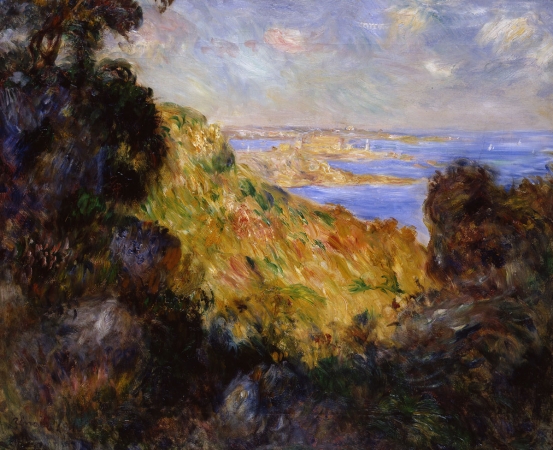
Pierre-Auguste RENOIR (1841-1919)
Bay of Salerno or Southern Landscape
1881
oil on canvas
46 x 55.5 cm
© MuMa Le Havre / Florian Kleinefenn
Bay of Salerno or Southern Landscape
1881
oil on canvas
46 x 55.5 cm
© MuMa Le Havre / Florian Kleinefenn
HD image
In 1881, Renoir embarked on a long journey that took him from Algeria to Italy. After spending some time in Venice, he headed to Rome where he was captivated by the Farnesina frescoes, before moving on to Naples in late 1881. A stone's throw from there, he painted Bay of Salerno, an astonishing landscape by the diversity of brushstrokes the artist employed to depict this bird's eye view of the Gulf of Salerno.
The painting from the Senn collection is composed of three successive planes, each with a different dominant colour. The foreground in overall tones of blue firmly sets the viewpoint, while the jagged hill in the background opens the space like an aerial perspective. In the middle, Renoir uses the juxtaposed strokes of thick, oily paint he had already experimented with in The Mosque (Paris, Musée d’Orsay).
The foreground, in which blurry bluish masses dance, hesitant, producing a sfumato effect, is the one most reminiscent of Renoir's Impressionist art and particularly the blue-coloured shadows of his great masterpieces composed around 1876. Although he strives to give this view a solid structure, Renoir still remains fully bound to colour: the middle ground, juxtaposing broad obliques of yellow, mauve and green, throbs with a fierce light whose forcefulness fades with distance.
While the drawing is still not strong in this artwork, the painting provides evidence of the vacillations of an artist racked by doubt about the quality of his art. Showing himself to be as masterly as ever, Renoir is most likely also anxious that this virtuosity is pushing him towards some sort of academicism.
The painting from the Senn collection is composed of three successive planes, each with a different dominant colour. The foreground in overall tones of blue firmly sets the viewpoint, while the jagged hill in the background opens the space like an aerial perspective. In the middle, Renoir uses the juxtaposed strokes of thick, oily paint he had already experimented with in The Mosque (Paris, Musée d’Orsay).
The foreground, in which blurry bluish masses dance, hesitant, producing a sfumato effect, is the one most reminiscent of Renoir's Impressionist art and particularly the blue-coloured shadows of his great masterpieces composed around 1876. Although he strives to give this view a solid structure, Renoir still remains fully bound to colour: the middle ground, juxtaposing broad obliques of yellow, mauve and green, throbs with a fierce light whose forcefulness fades with distance.
While the drawing is still not strong in this artwork, the painting provides evidence of the vacillations of an artist racked by doubt about the quality of his art. Showing himself to be as masterly as ever, Renoir is most likely also anxious that this virtuosity is pushing him towards some sort of academicism.
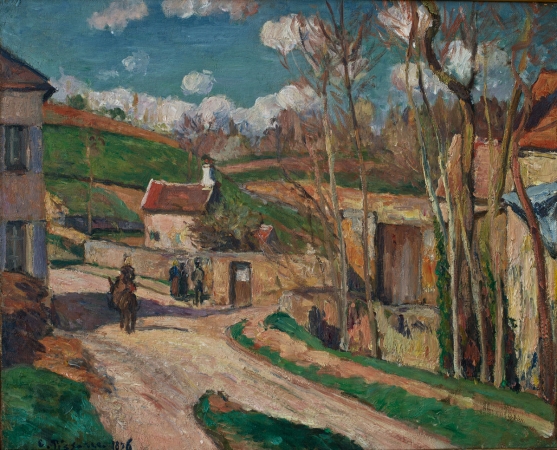
Camille PISSARRO (1831-1903)
Crossroads at L'Hermitage, Pointoise
1876
oil on canvas
38.5 x 46.5 cm
© MuMa Le Havre / David Fogel
Crossroads at L'Hermitage, Pointoise
1876
oil on canvas
38.5 x 46.5 cm
© MuMa Le Havre / David Fogel
HD image
During the war of 1870, Pissarro left France and set sail for England, where he discovered the work of Turner during visits to the National Gallery with Monet, who had also taken refuge across the Channel. The luminous magic of Turner's skies, his poetic interpretation of the weather and Monet’s use of small, rapid brushstrokes, his explorations into light and his reflections on the water are often cited as explanations of Pissarro's new approach to nature.
Back on French soil, bolstered by his new experiences, he left Louveciennes for L'Hermitage from 1872 to 1882. He grew attached to the simple motifs of a road leading to the village, the peaceful work of the farmers, the patchwork of fields on the hills, the changing colours of the seasons that give rhythm to this tranquil place.
In Crossroads at L'Hermitage, Pointoise, a few figures go about their daily life at a crossroads, as a bright sky dotted with plump clouds gives the autumn colours vibrancy. The composition is squarely set between the curtain of trees along the path to the right and the large, partially hidden building on the far left. The horizon line is thrown to the top of the canvas above the hills. By doing so, Pissarro disregards the matter of atmospheric effects so dear to Claude Monet, to concentrate on structuring and harmonizing the different planes into areas of vivid colour. A rhythm is established between the green of the fields cultivated on the hill and the reddish browns of the ploughed soil and the path.
Never had Pissarro achieved such a strong vibrancy of colour, adding orangey hues on the tiled roofs to bring out the brightness of the painting as a whole. He ceased striving to capture the immobility of the moment to develop a quick and tumultuous style that yields to the dazzle of the light-filled colour so typical of his work painted at Éragny.
Back on French soil, bolstered by his new experiences, he left Louveciennes for L'Hermitage from 1872 to 1882. He grew attached to the simple motifs of a road leading to the village, the peaceful work of the farmers, the patchwork of fields on the hills, the changing colours of the seasons that give rhythm to this tranquil place.
In Crossroads at L'Hermitage, Pointoise, a few figures go about their daily life at a crossroads, as a bright sky dotted with plump clouds gives the autumn colours vibrancy. The composition is squarely set between the curtain of trees along the path to the right and the large, partially hidden building on the far left. The horizon line is thrown to the top of the canvas above the hills. By doing so, Pissarro disregards the matter of atmospheric effects so dear to Claude Monet, to concentrate on structuring and harmonizing the different planes into areas of vivid colour. A rhythm is established between the green of the fields cultivated on the hill and the reddish browns of the ploughed soil and the path.
Never had Pissarro achieved such a strong vibrancy of colour, adding orangey hues on the tiled roofs to bring out the brightness of the painting as a whole. He ceased striving to capture the immobility of the moment to develop a quick and tumultuous style that yields to the dazzle of the light-filled colour so typical of his work painted at Éragny.
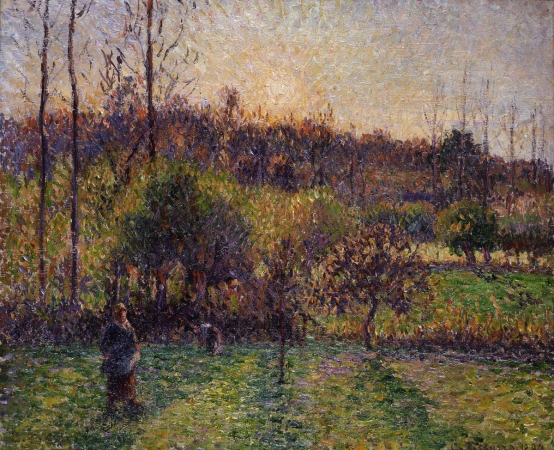
Camille PISSARRO (1831-1903)
Sunrise at Éragny
1894
oil on canvas
38.3 x 46 cm
© MuMa Le Havre / Florian Kleinefenn
Sunrise at Éragny
1894
oil on canvas
38.3 x 46 cm
© MuMa Le Havre / Florian Kleinefenn
HD image
Pissarro's move to Éragny and subsequent adherence to Neo-Impressionist theories marked a turning point in his artwork. His paintings became genuine odes to agriculture and peasant life, with the monumental human figure at the fore. He composed his artworks in the studio after numerous preparatory studies, resulting in rigorously structured landscapes with powerful statis and intense luminosity. Paradoxically, Pissarro's Neo-Impressionism introduced a transitory element, a moment of the day: the countryside appears enveloped in mist, bathed in sunlight, or blanketed in white snow.
His Neo-Impressionist period only lasted four years, from 1884 to 1888. He pursued the divisionist style in the following years, but not in a systematic way. When he painted Sunrise at Éragny, the Neo-Impressionist influence could be seen in the vibrant and luminous brushwork. The time of day is clearly defined in the title of the artwork. The skimming light of the sun rising over the countryside structures the painting into areas of green alternating with areas of shadow in strong backlight. The rays of sunlight filter through the poplars and fruit trees, creating an extremely refined effect of perspective.
Two figures melt into the shadows of the apple trees in the meadow and only gradually become distinguishable once our eye grows accustomed to the light. Pissarro painted in this location until the end of his life, familiar with every inch of the meadow, the tall beech trees lining it, the apple trees in the orchard next to the house, the plain and the rooftops of Bazincourt. Here we are in the meadow that borders Pissarro's house in Éragny, outlines of female figures can be made out in the branches. The brushstrokes are thick and oily. The motif remains.
His Neo-Impressionist period only lasted four years, from 1884 to 1888. He pursued the divisionist style in the following years, but not in a systematic way. When he painted Sunrise at Éragny, the Neo-Impressionist influence could be seen in the vibrant and luminous brushwork. The time of day is clearly defined in the title of the artwork. The skimming light of the sun rising over the countryside structures the painting into areas of green alternating with areas of shadow in strong backlight. The rays of sunlight filter through the poplars and fruit trees, creating an extremely refined effect of perspective.
Two figures melt into the shadows of the apple trees in the meadow and only gradually become distinguishable once our eye grows accustomed to the light. Pissarro painted in this location until the end of his life, familiar with every inch of the meadow, the tall beech trees lining it, the apple trees in the orchard next to the house, the plain and the rooftops of Bazincourt. Here we are in the meadow that borders Pissarro's house in Éragny, outlines of female figures can be made out in the branches. The brushstrokes are thick and oily. The motif remains.
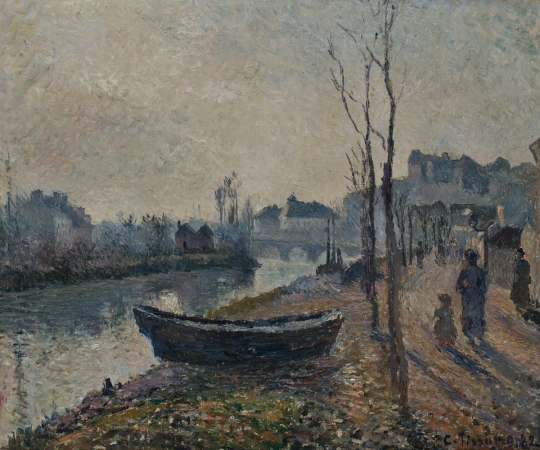
Camille PISSARRO (1831-1903)
Quai du Pothuis, Banks of the Oise
1882
oil on canvas
46.3 x 55.3 cm
© MuMa Le Havre / David Fogel
Quai du Pothuis, Banks of the Oise
1882
oil on canvas
46.3 x 55.3 cm
© MuMa Le Havre / David Fogel
HD image
On September 18, 1882, Pissarro, who had to leave Pontoise with great regret for financial reasons, wrote to his friend Monet who was looking for a house to rent in the area: "The countryside is very wholesome, especially on the sides and tops of the hills; lower, along the Oise, fog prevails; the houses are built on dried marshland."
We are on the banks of the Oise, on the Quai du Pothius opposite an island of the same name that stretches along the left side of the painting, below the old town of Pontoise outlined in the distance. In the background, the bridge from one side of the Oise to the other, the hôtel-Dieu just behind and the old town all blend in a harmony of silvery greys. The city emerges from the shadows, an incandescent silhouette, while the sun shines its final rays on the banks of the Oise.
Pissarro focuses here on the effects of weather, the light fog that bathes the landscape. The components merge beneath the setting sun that tints the sky, the ground and the water a golden pink hue. His brushwork is smaller, vibrant. Backlit passers-by melt into this colourful magic and give the artwork all its intimacy. Pissarro is not striving to describe a place, but rather recreate the mood it evokes.
It was in 1885 that Pissarro, who was living in Éragny, became aware of the new style he had adopted: "I am all the more distressed not to finish these studies for at present I am caught up in a transformation, and impatiently hoping for some kind of result. I hope nevertheless to make some progress. I assure you that this is causing me great torment; it is obviously a crisis!" The seeds of this work on sensation and impression, which led Pissarro down the path to Neo-Impressionism for several years, are already contained in this sunny painting.
We are on the banks of the Oise, on the Quai du Pothius opposite an island of the same name that stretches along the left side of the painting, below the old town of Pontoise outlined in the distance. In the background, the bridge from one side of the Oise to the other, the hôtel-Dieu just behind and the old town all blend in a harmony of silvery greys. The city emerges from the shadows, an incandescent silhouette, while the sun shines its final rays on the banks of the Oise.
Pissarro focuses here on the effects of weather, the light fog that bathes the landscape. The components merge beneath the setting sun that tints the sky, the ground and the water a golden pink hue. His brushwork is smaller, vibrant. Backlit passers-by melt into this colourful magic and give the artwork all its intimacy. Pissarro is not striving to describe a place, but rather recreate the mood it evokes.
It was in 1885 that Pissarro, who was living in Éragny, became aware of the new style he had adopted: "I am all the more distressed not to finish these studies for at present I am caught up in a transformation, and impatiently hoping for some kind of result. I hope nevertheless to make some progress. I assure you that this is causing me great torment; it is obviously a crisis!" The seeds of this work on sensation and impression, which led Pissarro down the path to Neo-Impressionism for several years, are already contained in this sunny painting.
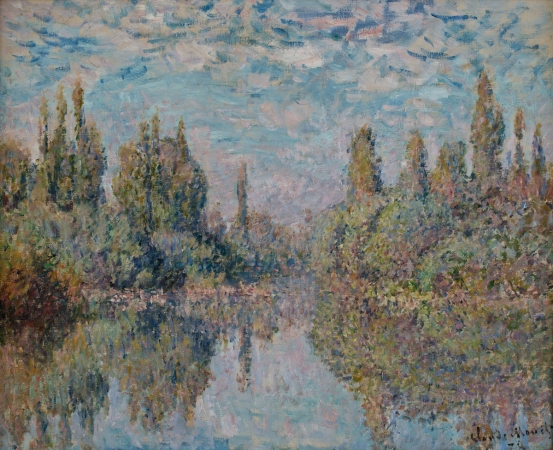
Claude MONET (1840-1926)
The Seine at Vétheuil
1878
oil on canvas
50. 5 x 61.5 cm
© MuMa Le Havre / David Fogel
The Seine at Vétheuil
1878
oil on canvas
50. 5 x 61.5 cm
© MuMa Le Havre / David Fogel
HD image
During the summer of 1878, financial difficulties forced Monet to leave Paris and live in Vétheuil. He moved into a little house on the road to Mantes with his family, Camille and their two sons, as well as the Hoschedé family.
"I have planted my tent on the banks of the Seine at Vétheuil in a ravishing spot."
Monet set about painting with great fervour to propose paintings to his most loyal supporters, Doctor Georges de Bellio and Caillebotte, who sought out clients for him and brought them to the studio that Caillebotte rented for the artist on Rue de Vintimille.
From Baudelaire's gentleman stroller in Paris to the painter of modernity in Argenteuil, Monet found himself looking out over the rural landscapes, a solitary spectator renewing with the paintings of Barbizon. The works painted upon his arrival are steeped in a sadness undoubtedly related to the worry caused by Camille's ailing health. Although his dreams of work and happiness were gradually giving way to discouragement, he exhibited in 1879 at the 4th Impressionist Exhibition so he would not appear, in his words, like a deserter.
At Vétheuil, the Seine, travelled by barges, was a major river trade route. The series of islands created a curtain that shielded the town from the boat traffic. In September 1878, Monet concentrated on this stretch of the Seine, portrayed from the riverbank or his studio-boat.
This small branch of the Seine at Vétheuil is painted downstream from the village, between the Moisson islands.
The golden morning light transfigures the early autumn. The surface of the painting has a truly vibratory effect, brought to life with brushwork he had already experimented with in Argenteuil. Fragmented in the foliage along the horizon, the strokes grow a touch longer in the symmetrical reflection. In a glaze only slightly more transparent, the reflection in the water inverts the tranquil activity of a late summer sky. Only the quick, broad strokes of the clouds, still high, are massed together, like a foreshadowing of the dark days to come.
"I have planted my tent on the banks of the Seine at Vétheuil in a ravishing spot."
Monet set about painting with great fervour to propose paintings to his most loyal supporters, Doctor Georges de Bellio and Caillebotte, who sought out clients for him and brought them to the studio that Caillebotte rented for the artist on Rue de Vintimille.
From Baudelaire's gentleman stroller in Paris to the painter of modernity in Argenteuil, Monet found himself looking out over the rural landscapes, a solitary spectator renewing with the paintings of Barbizon. The works painted upon his arrival are steeped in a sadness undoubtedly related to the worry caused by Camille's ailing health. Although his dreams of work and happiness were gradually giving way to discouragement, he exhibited in 1879 at the 4th Impressionist Exhibition so he would not appear, in his words, like a deserter.
At Vétheuil, the Seine, travelled by barges, was a major river trade route. The series of islands created a curtain that shielded the town from the boat traffic. In September 1878, Monet concentrated on this stretch of the Seine, portrayed from the riverbank or his studio-boat.
This small branch of the Seine at Vétheuil is painted downstream from the village, between the Moisson islands.
The golden morning light transfigures the early autumn. The surface of the painting has a truly vibratory effect, brought to life with brushwork he had already experimented with in Argenteuil. Fragmented in the foliage along the horizon, the strokes grow a touch longer in the symmetrical reflection. In a glaze only slightly more transparent, the reflection in the water inverts the tranquil activity of a late summer sky. Only the quick, broad strokes of the clouds, still high, are massed together, like a foreshadowing of the dark days to come.
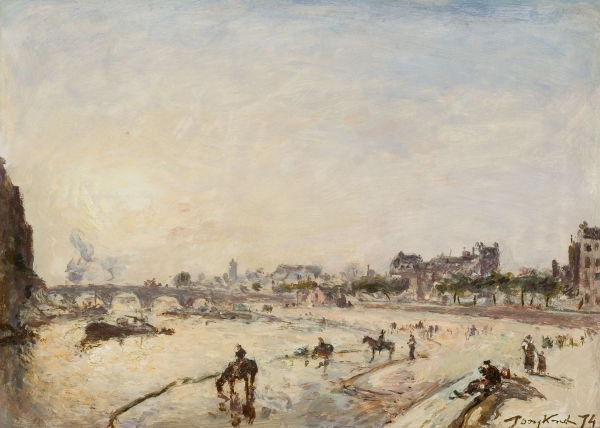
Johan Barthold JONGKIND (1819-1891)
Paris, Pont Marie and the Quai des Célestins
1874
oil on wood
23.5 x 32 cm
© MuMa Le Havre / Florian Kleinefenn
Paris, Pont Marie and the Quai des Célestins
1874
oil on wood
23.5 x 32 cm
© MuMa Le Havre / Florian Kleinefenn
HD image
Jongkind arrived in Paris in March of 1846 at the age of 27, but did not begin painting views of the city until two years later, in 1848. From then on, they became a recurring theme in his work. The bridges and quays in particular provided a variety of subjects he enjoyed painting throughout his life. He tirelessly repeated the points of view in series, some of which featured several variations. But above all, he loved to capture the city along the banks of the Seine and on the water.
The riverbanks were teeming with picturesque motifs: laundry boats, hoisting machines, goods of all sorts, as well as fishermen, boatmen, washerwomen, strollers, cartmen, haulers and their horses... Jongkind, who was familiar with these riverbank scenes in Holland, positioned himself on the quays, at the foot of bridges, and captured the bustling life, but limited it to a few scenes and figures. True to his training as a landscape painter, Jongkind favoured a vision that led him to balance his overall composition, rather than isolate a specific point of interest. The portion of sky, the effects of light, the reflections of the sun on the water were equally important and Jongkind took care to compose each one of his views harmoniously.
As was his custom, Jongkind used the river to draw the eye toward the back of the composition while the outline of the bridge and city serve to close the perspective. The horizon is set low beneath a luminous sky. The fine, lively, almost Pointillist application is typical of the artist's late works, used especially in landscapes with exaggerated effects of light (moonlight, setting sun, etc.).
Zola, who came to visit Jongkind at his Paris studio in 1872, noted with pleasure: "Everyone knows his marine landscapes, his views of Holland. But his other paintings are what delighted me, what instilled in me a particular taste. I want to talk about some of the parts of Paris he painted in recent years [...] I truly love the big city horizons. To my mind, there is a whole mine to be exploited, a whole modern art to be created" and concluded by saying "This profound love of modern Paris, I found it in Jongkind, I do not dare say with what joy."
The riverbanks were teeming with picturesque motifs: laundry boats, hoisting machines, goods of all sorts, as well as fishermen, boatmen, washerwomen, strollers, cartmen, haulers and their horses... Jongkind, who was familiar with these riverbank scenes in Holland, positioned himself on the quays, at the foot of bridges, and captured the bustling life, but limited it to a few scenes and figures. True to his training as a landscape painter, Jongkind favoured a vision that led him to balance his overall composition, rather than isolate a specific point of interest. The portion of sky, the effects of light, the reflections of the sun on the water were equally important and Jongkind took care to compose each one of his views harmoniously.
As was his custom, Jongkind used the river to draw the eye toward the back of the composition while the outline of the bridge and city serve to close the perspective. The horizon is set low beneath a luminous sky. The fine, lively, almost Pointillist application is typical of the artist's late works, used especially in landscapes with exaggerated effects of light (moonlight, setting sun, etc.).
Zola, who came to visit Jongkind at his Paris studio in 1872, noted with pleasure: "Everyone knows his marine landscapes, his views of Holland. But his other paintings are what delighted me, what instilled in me a particular taste. I want to talk about some of the parts of Paris he painted in recent years [...] I truly love the big city horizons. To my mind, there is a whole mine to be exploited, a whole modern art to be created" and concluded by saying "This profound love of modern Paris, I found it in Jongkind, I do not dare say with what joy."
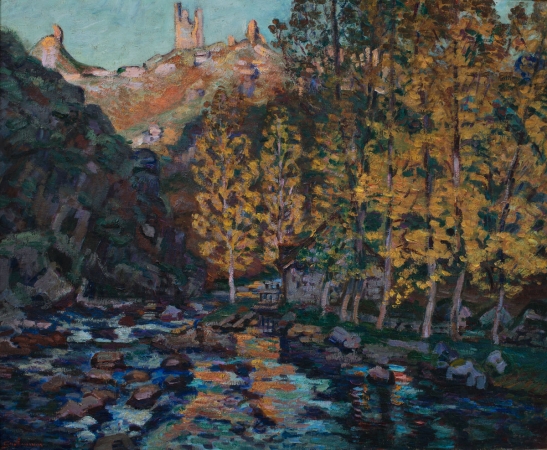
Armand GUILLAUMIN (1841-1927)
The Creuse at Crozant
ca. 1893
oil on canvas
60 x 73.5 cm
© MuMa Le Havre / David Fogel
The Creuse at Crozant
ca. 1893
oil on canvas
60 x 73.5 cm
© MuMa Le Havre / David Fogel
HD image
Grown weary of the Parisian cliques, Guillaumin moved to the Fresselines area in 1892. There he pursued a solitary career, working each day on a few of his favourite motifs. The site of the Brigand Mill, overlooking the ruins of the feudal castle of Crozant, was of particular interest to him. He loved to portray the contrasts of the steep cliff that lined the river to the left and the hedge of gracefully soaring poplars that partially concealed the mill.
In The Creuse at Crozant from the Senn collection, Guillaumin paints the site in the warm autumn sun with a play of complementary colours: orangey yellow leaves and shimmering blue reflections on the river. The ruins of the castle stand out against the clear purity of the sky. The artists makes use of harsh contrasts: the dark face of the cliff worked in broad strokes of brown, rust and off-green is echoed by the foliage of the poplars and the peak of the mountain in the background hit by the full force of the sun. This intensity of colours, ultramarine and vibrant orange, that captivated the young Friesz when he came to work with Guillaumin in 1901 is something the artist had cultivated for a long time.
As early as 1885, his palette adopted the most strident of hues. In the Creuse landscapes with a changeableness that Monet found distressing, Guillaumin’s use of colour came into its own. Olivier Senn also owned another artwork of the same motif, but a set from a viewpoint slightly further back (Bridge Over the Creuse, Crozant, pastel, 1896), in which the artist sets the tall spire of a poplar ablaze with his fiery palette. As with most of the places he was fond of, Guillaumin tirelessly returned to paint this location at different times of year. His loyalty to the Creuse and the old mill never waned, even when Père Brigand cut down the row of poplars along the river around 1905.
In The Creuse at Crozant from the Senn collection, Guillaumin paints the site in the warm autumn sun with a play of complementary colours: orangey yellow leaves and shimmering blue reflections on the river. The ruins of the castle stand out against the clear purity of the sky. The artists makes use of harsh contrasts: the dark face of the cliff worked in broad strokes of brown, rust and off-green is echoed by the foliage of the poplars and the peak of the mountain in the background hit by the full force of the sun. This intensity of colours, ultramarine and vibrant orange, that captivated the young Friesz when he came to work with Guillaumin in 1901 is something the artist had cultivated for a long time.
As early as 1885, his palette adopted the most strident of hues. In the Creuse landscapes with a changeableness that Monet found distressing, Guillaumin’s use of colour came into its own. Olivier Senn also owned another artwork of the same motif, but a set from a viewpoint slightly further back (Bridge Over the Creuse, Crozant, pastel, 1896), in which the artist sets the tall spire of a poplar ablaze with his fiery palette. As with most of the places he was fond of, Guillaumin tirelessly returned to paint this location at different times of year. His loyalty to the Creuse and the old mill never waned, even when Père Brigand cut down the row of poplars along the river around 1905.
LEARN MORE

























